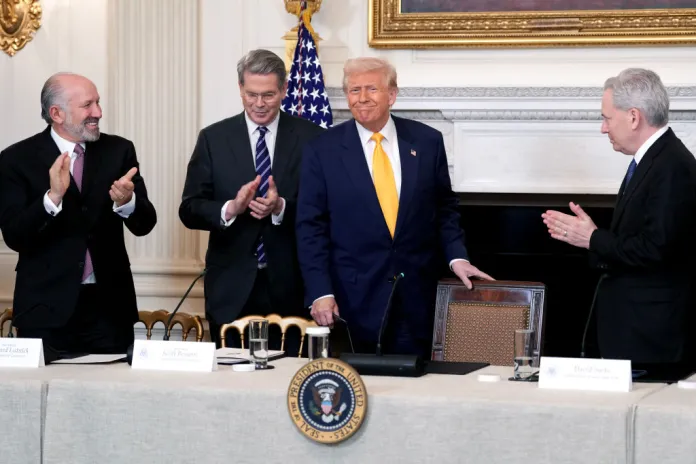Renewable energy and politics: can they coexist? – Washington Examiner
The article titled “Renewable energy and politics – can the two continue to mix?” discusses the intersection of renewable energy production and political dynamics in the United States, particularly in Texas, which is a significant producer of both oil and renewable energy. As a predominantly Republican state and a leader in wind and solar power production, Texas exemplifies a bipartisan approach to energy supply. However, with the upcoming presidential election and the potential return of Donald Trump, who advocates drilling, concerns arise about the future of bipartisan support for renewable energy.
A report from KKR points out that while political rhetoric and upcoming elections could influence clean energy policies, the overall outlook for renewables remains positive. The article also addresses the uncertainty surrounding the Inflation Reduction Act, which introduced funding and incentives for clean energy. Although the Act may face challenges if Republicans gain unified control, its impact on stimulating the renewable sector is expected to persist.
The growing demand for electricity, driven by developments in artificial intelligence and the increased adoption of electric vehicles, underscores the need for sustainable energy resources. Industry leaders argue that traditional energy sources such as natural gas and nuclear power will remain necessary to meet this rising demand, even as clean energy technologies continue to develop. despite potential political hurdles, global economic trends and the persistent need for energy are likely to maintain the momentum for renewable energy development in the U.S.
Renewable energy and politics — can the two continue to mix?
Texas is the largest oil producer in the United States. Nothing surprising there, but the state is also, perhaps less well known, the largest producer of wind energy. It also comes in second as the country’s largest producer of solar power, behind only California.
Perhaps that makes it a very good example of how energy supply, and the sources of such supply, is predominantly a bipartisan matter. A solidly Republican state is such a large producer of renewable energy after all, something not necessarily associated with so-called red states.
But as a highly polarized presidential election fast approaches, is there a danger that such examples of bipartisanship, or energy source neutrality, may fall by the wayside? After all, Republican nominee Donald Trump has said he would “drill, baby drill” from day one if the former president were to win the election and return to the White House.
In a June 2024 report on infrastructure trends, investors at KKR acknowledged that partisan politics could play some role in shaping specific policies. However, the extent of such a possible role is unknown and should also be largely balanced by the positive trend of green energy progress across the board.
“Our upbeat outlook on the renewables sector is generally independent of questions about the future of green energy related to the potential impact of the upcoming U.S. elections,” KKR said in the report titled Market Review Infrastructure June 2024.
What about that Inflation Reduction Act?
Nevertheless, questions remain, partly due to some of the political rhetoric but also over concerns over the uncertain future of the Inflation Reduction Act, signed into law in August 2022 under President Joe Biden and rejected by Republicans.
That law put in place billions of dollars in funding and tax incentives for clean energy innovation, research and development, and deployment, the KKR report noted.
While the Inflation Reduction Act is “unlikely” to be fully repealed in any future under a possible unified Republican control of government, there are certain programs within it that could be vulnerable, KKR said.
“We think that companies that have locked in funding are less risky investments than companies that are counting on funds being approved or allocated in the future,” the report said.
But even an unlikely repeal of the law would also not necessarily mean the end of clean energy, most would agree.
“Even after a potential repeal, the subsidies provided by the IRA will have set into motion a momentum for U.S. renewable energy which will not be easily halted,” said Mathilde Mounier, co-founder and COO at Powerweave, a digital software platform that helps improve energy efficiency.
Economic and political realities will also help prevent a move away from green energy, even in states where it may not be perceived as all that popular an issue.
“Subsidies for energy, clean or not clean, will likely continue as long as they show a benefit to some segment of American voters and to the American businesses that are bankrolling the campaigns of our elected officials,” said Mothusi Pahl, vice president of business development and government affairs at Modern Hydrogen, a Seattle-based clean energy solutions company.
Insatiable electricity demand
Meanwhile, the rise of artificial intelligence and its staggering data capabilities, as well as the move toward cleaner vehicles, will keep on pushing up requirements for electricity, whatever its source.
Electric vehicles alone are likely to add an estimated 700 terawatt-hours to the U.S. grid by 2050, said Hunter Bjork, founder and CEO at ISA Industries, an Arizona-based clean energy solutions company.
“With that in mind, developing clean and sustainable energy resources is imperative, and we believe efforts toward this objective will continue to be subsidized,” he said. “Green energy can initially augment traditional forms, minimizing grid strain.”
Such traditional forms will remain a big issue, some argue.
“This rapid increase in demand cannot be met by solar and wind alone,” according to Adam Ferrari, CEO of Phoenix Capital Group, a Denver-based oil and gas investment group. “It will necessitate substantial increases in either natural gas-fired power plants or nuclear generation.”
And while there have been some moves to promote increasing amounts of nuclear power generation, such as from Bill Gates, as well as subsidies in the Inflation Reduction Act, the regulatory process can be very burdensome, with projects taking years to approve. Other energy sources are, therefore, more likely to prevail.
Power generation is also a global matter and, therefore, one perhaps way outside of any perceived political control U.S. elected representatives may think they have. Such global forces will drive investments in the sector.
“It is clear that rising geopolitical uncertainty and increasingly severe weather events are driving investment into next-generation energy around the world, regardless of which way political winds blow here at home,” said Michael Jung, director of government affairs and public policy at Modern Hydrogen.
So, while some politicians may like to diss green energy, using it as fodder to rile up easy base support, global economic forces are likely to be a way stronger factor in the long run.
“Green energy is undoubtedly here to stay,” said Rue Phillips, president and co-founder of SkillFusion, a digital customer service platform for the training of electric vehicle professionals. “While political shifts can influence the level of support and funding for renewable energy, the momentum behind green energy is driven by market forces, technological innovation, and a global commitment to reducing carbon emissions.”
All that said, more traditional forms of energy still significantly outpace renewables, with any change to a completely clean economy some way off, Pahl at Modern Hydrogen said.
CLICK HERE FOR MORE FROM THE WASHINGTON EXAMINER
But the changes are there, and it will be forces far greater than one U.S. election cycle that will prevail.
“The future of clean energy is bright and increasingly bipartisan,” Bjork at ISA said. “While the economics of subsidies may shift with the results of the next election, the core need for sustainable energy transcends political lines.”
Nick Thomas is a writer based in Denver, Colorado.
" Conservative News Daily does not always share or support the views and opinions expressed here; they are just those of the writer."




